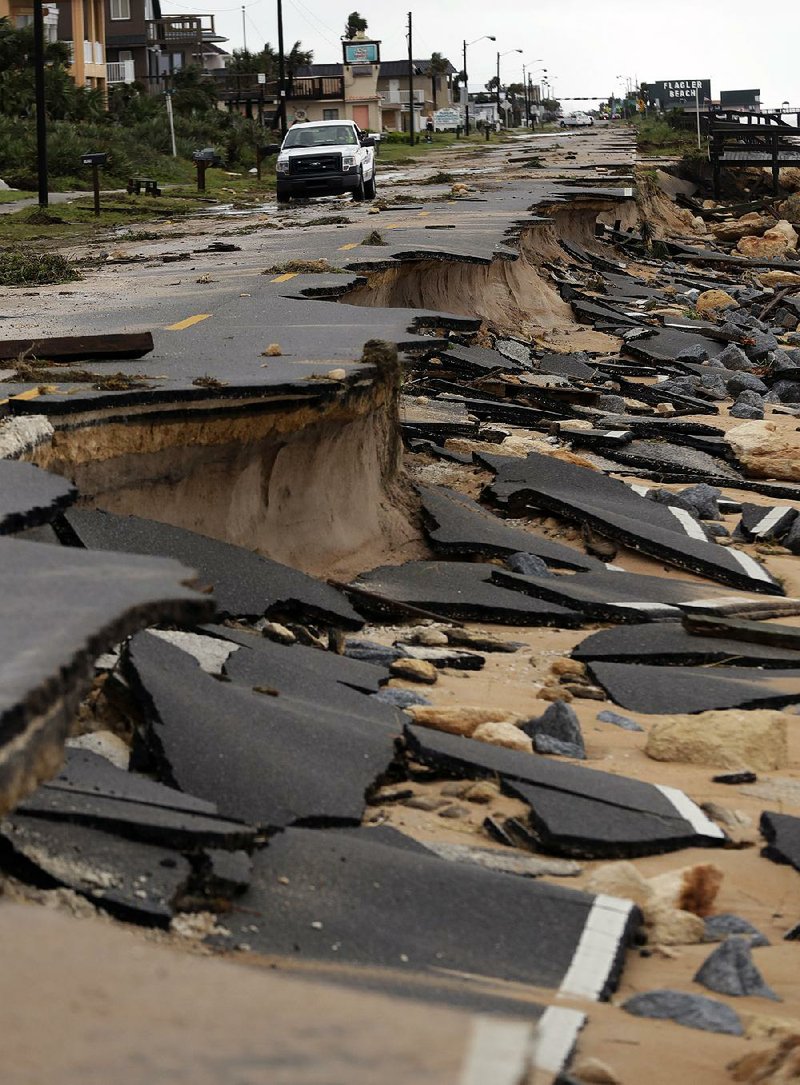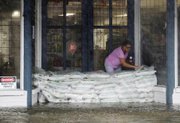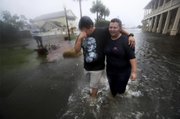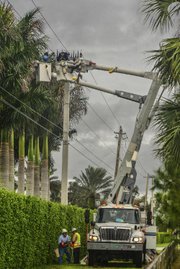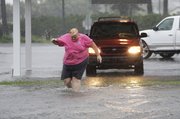AUGUSTINE, Fla. -- Hurricane Matthew spared Florida's most heavily populated stretch from a catastrophic blow Friday but threatened some of the South's most historic and picturesque cities with ruinous flooding and wind damage as it pushed its way up the coastline.
RELATED ARTICLE
http://www.arkansas…">Haitians pick up pieces, but Matthew took much
Among the cities in the cross hairs were St. Augustine, Fla.; Savannah, Ga.; and Charleston, S.C.
"There are houses that will probably not ever be the same again or not even be there," St. Augustine Mayor Nancy Shaver lamented as battleship-gray floodwaters coursed through the streets of the 451-year-old city founded by the Spanish.
Matthew -- which has weakened significantly since it was named the most powerful hurricane to threaten the Atlantic Seaboard in more than a decade -- set off alarm as it closed in on the U.S., having left nearly 300 people dead in Haiti.
[ MATTHEW'S IMPACT: Map of power outages, shelters]
[HURRICANE TRACKER: Follow Hurricane Matthew’s path so far]
In the end, it sideswiped Florida's Atlantic coast early Friday, swamping streets, toppling trees onto homes and knocking out power to more than 1 million people. But it stayed just far enough offshore to prevent major damage to cities like Miami, Fort Lauderdale and West Palm Beach. And the coast never felt the full force of its 120-mph winds.
"It looks like we've dodged a bullet," said U.S. Rep. Patrick Murphy, a Democrat whose district includes Martin County, just north of West Palm Beach.
At least four people died in Florida. An elderly St. Lucie County couple died from carbon monoxide fumes while running a generator in their garage, and two women were killed in separate events when trees fell on a home and a camper. Two others died in medical emergencies that ambulances couldn't reach on time.
More than 1 million people in Florida lacked power because of the storm, according to the office of Gov. Rick Scott.
While the hurricane was weakening quickly, several northeastern Florida cities, including Jacksonville, were still in harm's way, along with communities farther up the coast. Authorities warned that not only could Matthew easily turn toward land, but it also could cause deadly flooding with its surge of seawater.
[WATCH: Video shows plane flying into eye of Hurricane Matthew]
The storm's surge had been projected as high as 11 feet. Scott said he was particularly worried about Jacksonville.
On Friday afternoon, video footage on social media showed water breaking through barriers surrounding Jacksonville, which is right along the coast.
The storm gouged out several large sections of the coastal A1A highway north of Daytona Beach and nearly had washed out completely the northbound lane for about a mile at Flagler Beach.
"It's pretty bad, it's jagged all over the place," said Oliver Shields, whose two-story house is within sight of the highway.
About 500,000 people were under evacuation orders in the Jacksonville area, along with another half-million on the Georgia coast. More than 300,000 fled their homes in South Carolina. The latest forecast showed the storm also could scrape the North Carolina coast.
"If you're hoping it's just going to pass far enough offshore that this isn't a problem anymore -- that is a very, very big mistake that you could make that could cost you your life," National Hurricane Center Director Rick Knabb warned.
St. Augustine, which is the nation's oldest permanently occupied European settlement and includes a 17th-century Spanish fortress and many historic homes turned into bed-and-breakfast inns, was awash in rain and seawater that authorities said could top 8 feet.
"It's a really serious devastating situation," the mayor of the city of 14,000 said. "The flooding is just going to get higher and higher and higher."
President Barack Obama said Friday that much like during Sandy in 2012, the storm surge could cause significant damage.
"I want to emphasize to everybody that this is still a really dangerous hurricane," Obama said during remarks in the Oval Office after he met with the heads of the Federal Emergency Management Agency and Department of Homeland Security.
Obama again urged residents to listen to what local officials are saying, expressing concerns about areas in northern Florida and Georgia.
"Do not be a holdout here because we can always replace property, but we can't replace lives," he said.
Obama had declared emergencies in four states -- Florida, Georgia, South Carolina and, on Friday, North Carolina -- opening up federal aid and assistance. Governors also declared emergencies and activated thousands of National Guard members to help with the response.
Across the southeastern United States, officials pleaded all week with residents to take seriously the threat of a storm that would be the strongest hurricane to hit the country since Wilma in 2005.
At 8 p.m. Central time, Matthew was centered about 50 miles southeast of St. Simons Island, Ga., and moving north at 12 mph. Its wind speed had dropped to 110 mph, down from 145 mph when it smashed into Haiti.
'certain danger'
Flood warnings were issued through late Friday for northern Nassau County, in Florida not far from the Georgia line, as well as Camden and Glynn counties in southeastern Georgia, the National Weather Service said.
"Let's not underestimate how dangerous this hurricane can be," Georgia Gov. Nathan Deal said at a news conference Friday. "There's nothing certain about this other than the danger."
Matthew's outer bands began lashing Savannah, a city that was settled in 1733 and has a handsome historic district of moss-draped trees, brick and cobblestone streets, Greek revival mansions and other 18th- and 19th-century homes.
Matthew was expected to whip up winds of 50 to 60 mph that could snap branches from the burly live oaks and damage the historic homes. And 8 to 14 inches of rain could flood some streets.
Savannah-Chatham County Police Chief Jack Lumpkin said officers will enforce a dusk-until-dawn curfew.
A small crew of workers Thursday set out to button up the Owens-Thomas house, one of Savannah's architectural gems. The 1819 Greek revival mansion serves as a museum.
Sonja Wallen, a curator, said antique rugs and furniture were moved away from the home's more than 40 windows, many of them still with their original glass. Windows were fitted with plywood and other coverings, while sandbags were stacked at the basement entrance.
"It's basically a lot of little details -- sandbags and duct tape around doorways where water can get in," Wallen said. "It's pretty much the same stuff you would do for any home."
Some of Georgia's resort islands were expected to take the brunt of Matthew's storm surge, including St. Simons and Tybee.
On Tybee Island, where most of the 3,000 residents were evacuated, Jeff Dickey held out hope that the storm might shift and spare his home. But as the rain picked up, he decided staying wasn't worth the risk.
"We kind of tried to wait to see if it will tilt more to the east," Dickey said. "But it's go time."
Mayor Jason Buelterman personally called some of the holdouts, hoping to persuade them to move inland.
"This is what happens when you don't have a hurricane for 100 years," he said. "People get complacent."
Historic downtown Charleston, S.C., usually bustling with tourists who flock to see the city's beautifully maintained antebellum homes, was eerily quiet, with many stores and shops boarded up with plywood and protected by stacks of sandbags.
Airlines canceled at least 5,000 flights Wednesday through today, including many in and out of Orlando, where all three of the resort city's world-famous theme parks -- Walt Disney World, Universal Studios and SeaWorld -- closed because of the storm.
But things began getting back to normal, with flights resuming in Miami and other south Florida airports.
In areas the storm had already passed, residents and officials began to assess the damage.
Robert Tyler had feared the storm surge would flood his street two blocks from the Cape Canaveral beach. Tree branches fell, he could hear transformers exploding overnight, and the windows seemed as if they were about to blow in, despite the plywood over them.
But in the morning, there wasn't much water, his home didn't appear to be damaged on first inspection, and his vehicles were unharmed.
"Overnight, it was scary as heck," Tyler said. "That description of a freight train is pretty accurate."
Information for this article was contributed by Brendan Farrington, Holbrook Mohr, Gary Fineout, Kelli Kennedy, Terry Spencer, Jennifer Kay, Freida Frisaro, Curt Anderson, Marcia Dunn, Janelle Cogan, Russ Bynum, Martha Waggoner, Jeffrey Collins, Jack Jones, Meg Kinnard and Bruce Smith of The Associated Press and by Arelis R. Hernandez, Mark Berman, Renae Merle, Lacey McLaughlin, Lori Rozsa, Dustin Waters, Angela Fritz, Brian Murphy and Susan Hogan of The Washington Post.
A Section on 10/08/2016
